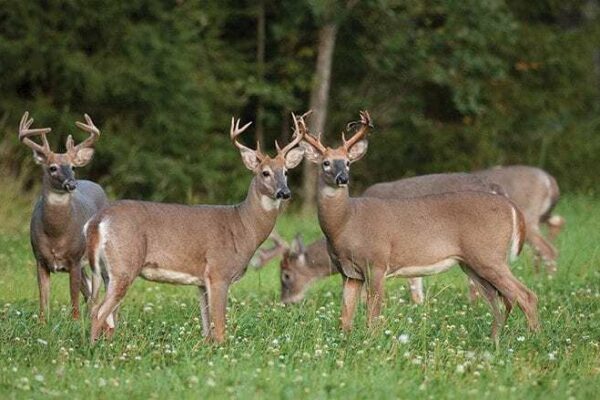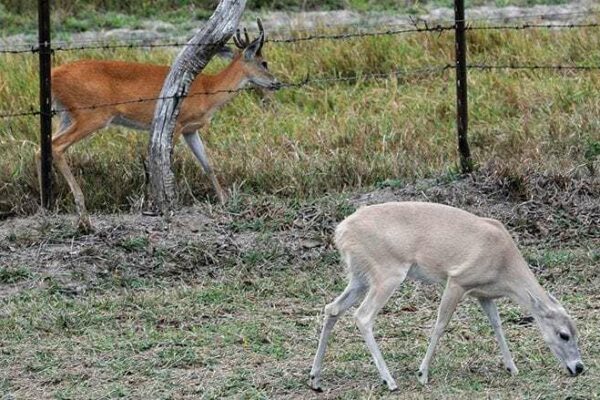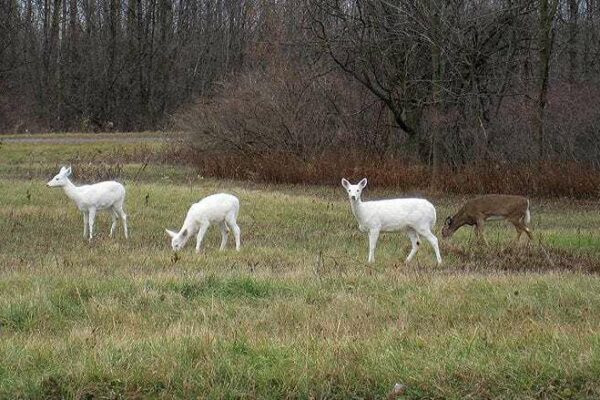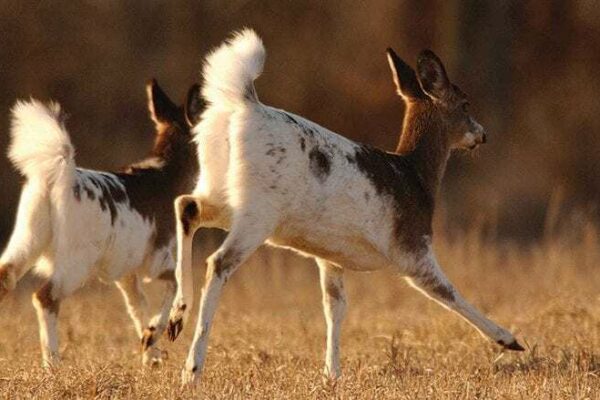By Jim Heffelfinger
Bird and reptile enthusiasts enjoy an endless variety of colorful combinations worn by their favorite animals. We all know every member of the deer family is so much more likable than anything the bird or reptile family has to offer, but we have to admit that deer do not use very much of the color palette. We basically have different shades of brown. Among the shades of brown are those big brown eyes, which account for much of the deer’s appeal. Although we don’t have the vivid colors of other animals, we do see variations in the coloration of deer and that sparks interesting discussions about the cause and reason for color differences. With the dramatic increase in remote cameras in recent years, we are now documenting a lot of strange variations in animal behavior and appearance. The internet highway, driven by vehicles like Instagram, Twitter, Facebook, and discussion forums, are delivering pictures to our computers and phones in a constant stream of productivity-diverting posts.
Some oddities and color variations cannot be explained easily, but others are the result of well-documented conditions. Although known to science, the reasons for deer color variations are not well understood to most hunters and members of the public. Your social media-surfing experiences can be enhanced with an overview of the many reasons we see all these different shades of deer.
Sometimes there is no label or name for some natural variations in the color of individuals. This natural variation is the raw material that domestic animal breeders used for centuries to produce new breeds and variations. With even a rare trait, breeders can concentrate that characteristic and “breed for it” to increase its prevalence in the herd or population. Sometimes we see deer or elk with a coat color described as “cream-colored” that is about half as dark as their companions. It is not entirely clear what causes these lighter animals, but evidently something is interfering with the deposition of the correct amount of pigment in the hair as it grows. It has been said that increased testosterone in older males contributes to the darker color we see on mature males. That relationship is not well documented, but we do see darker features on old bucks and bulls.
Some animals may appear lighter or darker even if there is no difference in the true color. For example, the lighting we observe the deer in can make a difference in how they look. Every year there are many reports of “black panthers” around the country even though we have no such thing north of the black jaguars in Central America. Some of these are dogs, but others are mountain lions that are seen in poor lighting conditions. It only takes a little shade and harsh sunlight to turn a tan animal into a black one. Also, especially in deer, males make their hair stand on end in an aggressive posture to look bigger and darker to rival males. This behavior is effective because agitated bucks do look considerably darker.
Some deer also have white around the hooves in what is sometimes called “socks” or small speckling on the brisket or legs. These types of minor variations in coat color seem to have some genetic component because these characteristics can be found in local clusters within a population.
There is some variation in the brown coat of a deer as one travels around the geographic range of whitetails. Since white-tailed deer are found from the Boreal Forest of Canada to the tropical savannas of South America, there is considerable local variation as they have adapted to an incredible diversity of environmental conditions. As a rule, deer in arid environments are pale in comparison to their northern and eastern relatives, and the difference between summer and winter coats is less striking. Deer in forested environments are darker on the average than their open-country cousins. As with all wildlife coloration, there are considerable variations in every population. In the Apure Region of Venezuela there is a lighter color phase that is seen and also a unique pattern where the deer have much more white on the underside of the jaw and the white “bib” continues down to the brisket.
Let’s not overlook the fact that deer replace all their fur twice each year in a complete hair molt. This usually results in a reddish-brown summer coat and a grayish-brown winter coat. The transition between coats occurs in late summer and spring with the spring molt more obvious due to the shedding of the woolly under fur. Like other natural annual cycles (antlers and rut), the timing of shedding and replacing the pelage is controlled by hormones that are regulated primarily by photoperiod (day length). There is a strong genetically based component to these cycles that interact with photoperiod that can be seen when you move deer to a different state and find they molt at a different time than the native deer.
The winter coat is grown in August-September each year as the summer coat is shed. This winter coat has long guard hairs and short insulating underfur. The summer coat is usually very reddish and its growth begins during April-June as the winter coat is shed. The summer pelage consists of shorter guard hairs that are not hollow and it lacks the woolly layer of underfur insulation. The summer coat of many southwestern deer, including the Texas whitetail, is not very red and maintains a more grayish appearance. All these natural changes create seasonal changes in the shades of brown we see in the deer herd.
The most striking and obvious coat color variation is the albino deer. Albino deer lack an enzyme that is necessary to produce the dark pigment called “melanin” in their cells so all hair, hooves, and skin are without color pigments. The non-pigmented skin with blood vessels running through it looks pink. These deer have white hair, pink eyes, pink noses, cream or pink hooves, and even white antler velvet. The dried blood from the velvet and the tannins in tree bark still stain the fresh antlers just like normal bucks. In fact, when the antlers are hardened and polished they are the only thing that appear the same as a normally-colored buck. True albinos lack pigment in the iris of the eye and this is important because the iris constricts to dilate the pupil closed to filter out excessive light. Without dark pigment in the pink iris, the albino’s eye cannot block as much sunlight and it is uncomfortable for them to be in direct sunlight. This lack of pigment in the eye tissue also affects the retina and means albinos usually cannot see as well.
Albinism is a recessive genetic condition, which means if both parents possess this rare genetic trait, some of the offspring can be albinos. Two normally colored parents can produce albino offspring and pure albinos are not sterile. Purposely breeding deer known to carry this trait will concentrate this characteristic in the gene pool and increase its occurrence. Breeding two albinos will produce nothing but albinos because each albino carries the double recessive albinism gene. Sometimes eye disorders are associated with albinos, but in all other respects they are usually as healthy as brown deer.
Albinism has been documented in mammals, fish, reptiles, birds, amphibians, and even plants. It seems to be more common in some types of animals and almost unheard of in others. Albino moose, elk, caribou, white-tailed deer, mule deer, roe deer, muntjac, and red deer have been reported and photographed. Both albino whitetails and mule deer have been reported in southwestern deer herds, but they seem to be less common than in the northern part of deer range. Perhaps the more direct sunlight or visual exposure to predators in the Southwest places them at a greater disadvantage.
Many “albino” deer are not really albinos. That is, they don’t have the double recessive gene that results in a total lack of pigment. They may be partially or totally white, but do not have the characteristic pink eyes and skin. Deer that are totally white, but have normal colored eyes, skin, and hooves are called Leucistic. Leucistic deer have melanin, but there is a problem with the process that deposits it in the skin and hair. The genetics behind leucistic deer is not as clear as albinos. The mating of 2 pure white leucistic deer can result in normally colored fawns.
There have been reports from the Midwest of all-white deer with very pink skin, but blue or gray eyes. Blue eyes are actually a sign of less pigment, but strictly speaking, albinos are the result of a complete lack of pigment. A famous herd of leucistic deer occupy the former Seneca Army Depot in western New York. This high-fenced 10,600-acre military property protected all white deer since the first were seen in 1949. At one time that herd of about 800 deer included 200 completely white deer, but the Depot has since been decommissioned and the lack of fence maintenance has resulted in only about 75 left on the property.
Some deer are partially white, but are not albinos. The piebald (sometimes called pinto deer) condition is also a genetic abnormality whereby the deer produces melanin, but it is deposited in the skin and hair in patches here and there. These deer can have pigmented hooves, eyes, and skin; lacking pigment only in some random areas of their pelt. Besides varying degrees of white fur, piebald deer have other genetic abnormalities like short legs, deformed feet, a bowed nose, arching spine, short jawbones, and oddly formed internal organs. The most severely deformed die soon after birth, but those with minor physical problems can live to adulthood. A piebald deer bred to another piebald is reportedly a lethal combination. Piebalds are the most common of the abnormal pelage colorations, but still relatively rare on a percentage basis.
On the opposite end of the spectrum from white deer are those that produce too much melanin pigment and have very dark or black fur. Melanism is simply the excess of dark pigmentation. There is actually a wide range of shades of darkness that all fall under the category of melanism. Melanistic deer can range from jet black all over (usually the undersides are a shade lighter), or may have some pure white hairs under the tail, around the anus, and sometimes on the tarsal and metatarsal glands. Melanistic deer always have a very dark face, ears, and a dark stripe down the mid-back from the head to tail. Some of these melanistic deer are a beautiful dark, sooty color or even chocolate brown.
This coloration is even rarer than “white deer,” and it would seem such a dark individual would be at a great disadvantage during the hot summer months when trying to keep cool. However, in northern areas they would be able to stay warm and possibly hide in the forest better than their counterparts. Texas has the largest cluster of melanistic deer in central Texas. An area containing Hays, Travis, Comal, Caldwell, and Guadalupe counties has the highest concentration of “dark deer” anywhere in the world. Even though this oddity is very rare worldwide, researchers John Baccus and John Posey of Texas State University surveyed this area and found 21 percent of the deer in the center of the cluster were abnormally dark to some degree. The percentage of dark deer lessened as they surveyed away from ground zero of the “black hole.”
Fawns normally retain their spots for 40-80 days, but in unusual cases the spots may stick around for years. Once in a great while an adult deer is harvested with fawn-like spots. Most commonly these deer may retain just a double row of spots – one on each side of the spine. Some deer may have more, even continuing down the sides. Sometimes this generates rumors of an axis deer -whitetail hybrid, but there is no record of white-tailed deer crossing with any of the “Old World” deer (fallow, axis, sika, etc.). It is not known what causes the retention of these spots in rare cases.






